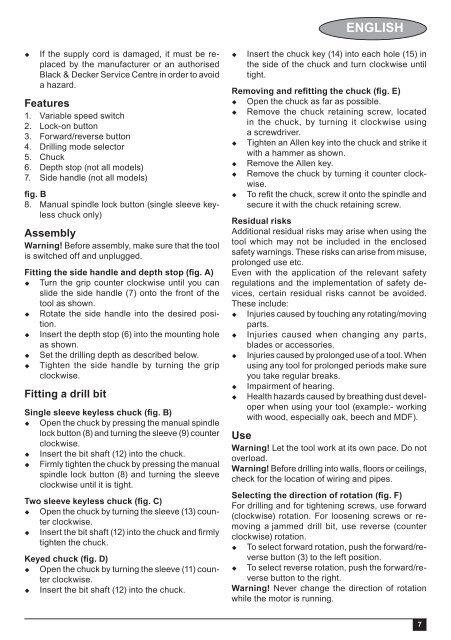BlackandDecker Marteau Perforateur- Cd714cres - Type 1 - Instruction Manual (Européen)
BlackandDecker Marteau Perforateur- Cd714cres - Type 1 - Instruction Manual (Européen)
BlackandDecker Marteau Perforateur- Cd714cres - Type 1 - Instruction Manual (Européen)
You also want an ePaper? Increase the reach of your titles
YUMPU automatically turns print PDFs into web optimized ePapers that Google loves.
ENGLISH<br />
<br />
If the supply cord is damaged, it must be replaced<br />
by the manufacturer or an authorised<br />
Black & Decker Service C<strong>en</strong>tre in order to avoid<br />
a hazard.<br />
Features<br />
1. Variable speed switch<br />
2. Lock-on button<br />
3. Forward/reverse button<br />
4. Drilling mode selector<br />
5. Chuck<br />
6. Depth stop (not all models)<br />
7. Side handle (not all models)<br />
fig. B<br />
8. <strong>Manual</strong> spindle lock button (single sleeve keyless<br />
chuck only)<br />
Assembly<br />
Warning! Before assembly, make sure that the tool<br />
is switched off and unplugged.<br />
Fitting the side handle and depth stop (fig. A)<br />
Turn the grip counter clockwise until you can<br />
slide the side handle (7) onto the front of the<br />
tool as shown.<br />
Rotate the side handle into the desired position.<br />
Insert the depth stop (6) into the mounting hole<br />
as shown.<br />
Set the drilling depth as described below.<br />
Tight<strong>en</strong> the side handle by turning the grip<br />
clockwise.<br />
Fitting a drill bit<br />
Single sleeve keyless chuck (fig. B)<br />
Op<strong>en</strong> the chuck by pressing the manual spindle<br />
lock button (8) and turning the sleeve (9) counter<br />
clockwise.<br />
Insert the bit shaft (12) into the chuck.<br />
Firmly tight<strong>en</strong> the chuck by pressing the manual<br />
spindle lock button (8) and turning the sleeve<br />
clockwise until it is tight.<br />
Two sleeve keyless chuck (fig. C)<br />
Op<strong>en</strong> the chuck by turning the sleeve (13) counter<br />
clockwise.<br />
Insert the bit shaft (12) into the chuck and fi rmly<br />
tight<strong>en</strong> the chuck.<br />
Keyed chuck (fig. D)<br />
Op<strong>en</strong> the chuck by turning the sleeve (11) counter<br />
clockwise.<br />
Insert the bit shaft (12) into the chuck.<br />
<br />
Insert the chuck key (14) into each hole (15) in<br />
the side of the chuck and turn clockwise until<br />
tight.<br />
Removing and refitting the chuck (fig. E)<br />
Op<strong>en</strong> the chuck as far as possible.<br />
Remove the chuck retaining screw, located<br />
in the chuck, by turning it clockwise using<br />
a screwdriver.<br />
Tight<strong>en</strong> an All<strong>en</strong> key into the chuck and strike it<br />
with a hammer as shown.<br />
Remove the All<strong>en</strong> key.<br />
Remove the chuck by turning it counter clockwise.<br />
To refi t the chuck, screw it onto the spindle and<br />
secure it with the chuck retaining screw.<br />
Residual risks<br />
Additional residual risks may arise wh<strong>en</strong> using the<br />
tool which may not be included in the <strong>en</strong>closed<br />
safety warnings. These risks can arise from misuse,<br />
prolonged use etc.<br />
Ev<strong>en</strong> with the application of the relevant safety<br />
regulations and the implem<strong>en</strong>tation of safety devices,<br />
certain residual risks cannot be avoided.<br />
These include:<br />
Injuries caused by touching any rotating/moving<br />
parts.<br />
Injuries caused wh<strong>en</strong> changing any parts,<br />
blades or accessories.<br />
Injuries caused by prolonged use of a tool. Wh<strong>en</strong><br />
using any tool for prolonged periods make sure<br />
you take regular breaks.<br />
Impairm<strong>en</strong>t of hearing.<br />
Health hazards caused by breathing dust developer<br />
wh<strong>en</strong> using your tool (example:- working<br />
with wood, especially oak, beech and MDF).<br />
Use<br />
Warning! Let the tool work at its own pace. Do not<br />
overload.<br />
Warning! Before drilling into walls, fl oors or ceilings,<br />
check for the location of wiring and pipes.<br />
<br />
Selecting the direction of rotation (fig. F)<br />
For drilling and for tight<strong>en</strong>ing screws, use forward<br />
(clockwise) rotation. For loos<strong>en</strong>ing screws or removing<br />
a jammed drill bit, use reverse (counter<br />
clockwise) rotation.<br />
To select forward rotation, push the forward/reverse<br />
button (3) to the left position.<br />
To select reverse rotation, push the forward/reverse<br />
button to the right.<br />
Warning! Never change the direction of rotation<br />
while the motor is running.<br />
7
















